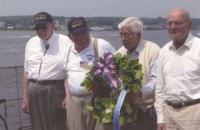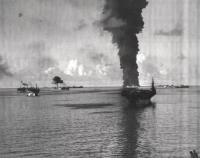
Serving the Vermont Champlain Valley Area for 45 Years
Main SectionsFront Page SportsValley VitalsIt's in the StarsStarwiseArchivesLinksAbout The VoiceContact Us |
“A test against the enemy and the sea”: Sharing Memories with Winston W. WhittenTuesday December 2, 2008 By Cookie Steponaitis To most Americans the mention of the South Pacific congers up images of tropical paradise, blue ocean, warm breezes and exotic vacation destinations. To Winston Whitten and the men of the USS Mississinewa (AO-59), the Pacific Ocean of 1944, was one of war time danger. The Mississinewa was An Ashtabula class tanker that was used for carrying and re fueling American ships and planes in the war. The tanker was 553 feet long and carried 140,000 barrels of ship fuel as well as 100,000 gallons of high octane plane fuel. With a ship’s complement of 278 enlisted men and 21 officers, the tanker was laid down by the Bethlehem Sparrows Point Shipyard in Maryland and was launched on March 28, 1944. After an entry cruise in the Chesapeake Bay, the ship entered into wartime service on May 11, 1944 and first refueled ships for the third fleet. Serving aboard the Mississinewa was 1st Class Machinist Mate W.W. Whitten. Born in Lincoln, Maine in 1922, W.W.W. was working for General Electric as an apprentice tool and dye maker when Pearl Harbor was attacked and enlisted in the US Navy in September of 1942 in Portsmouth, Rhode Island. When questioned about his choices at time of enlistment, he simply shook his head and responded, “It wasn’t about choosing. America was at war. They placed you where you could be used based on your background.” After being sent to Great Lakes, Illinois for sixteen weeks of training, W.W. W. found himself assigned to the tanker US Enoree (A069) as a Machinist Mate Second Class. During 1943, the Enoree made three trips across the Atlantic Ocean to help refuel the US Fleet. Stopping and re loading in Casablanca, there were often hundreds of ships in the groups crossing the ocean. W.W.W. remarked that his position was in the “Engine Room and that he was the throttle man. He took orders from the bridge and increased or decreased speeds as needed to maneuver the huge tanker into different positions.” In early 1944, W.W.W. was sent back to school again in Norfolk, Virginia and then assigned as a 1st Class Machinist Mate to the USS Mississinewa. W.W.W. joined the crew as a “pollywog” and was upgraded to “shellback” status as the ship moved to the Pacific front. When questioned about these terms, Mr. Whitten smiled and explained that, “ men who had never crossed the equator were called pollywogs and once you had achieved that distinction you were christened shellbacks in a ceremony on deck.” Early in March of 1944, the Mississinewa went through the Panama Canal and joined active duty in the Pacific fleet. From August to October, 1944 the Mississinewa and W.W.W. were involved in four active missions and engagements in the Pacific. All aboard were awarded battle starts for the August 31,1944-September 8, 1944 raids on the volcano-Bonin Islands; the September 6, 1944-October 13,1944 capture and occupation of the Southern Palau Islands, the September –September 24, 1944 assault on the Philippines and the October 10, 1944 support of operations in the Okinawa attack. November 20, 1944 found the tanker refueled with 404,000 gallons of aviation gas, 9,000 barrels of diesel oil, and 90,000 barrels of fuel oil and anchored in berth No. 131 in Ulithi Lagoon outside of Palau. In the early morning hours a heavy explosion rocked the tanker. Seconds later, fumes in an aviation gas cargo tank ignited, causing a second explosion. Massive flames immediately burst from midship forward. Oil immediately engulfed the ship, with aviation gas on top of that. The aviation gas was fanned by a wind and the fire spread aft quickly. A few minutes later the fires reached the magazine and caused yet another explosion. W.W.W. remembers that, “I was a sleep on the well deck, which was in the aft part of the tanker. We were hit by a torpedo from a suicide Japanese sub known as a Kaiten. In Japanese, this term translates to, “the turning of the heavens.” We were knocked out of the bunks and on to the decks. Fire was roaring down the deck. Fire and choking smoke engulfed the ship, forcing us to the stern. I managed to jump and get into a lifeboat that contained several men. We were able to pull some 20 men out of the water. Many were burned badly. We went to the USS Lackawanna, leaving the wounded and went back bringing another fifteen or twenty to safety. 63 men went down with the ship that day and the tanker sunk to the bottom.” The flames from the Mississinewa shot over 100 feet into the air and were so brilliant on the horizon that the Japanese mistakenly notified headquarters that the submarine had sunk an aircraft carrier. While tugs and other boats tried to put out the flames, the tanker was lost and sunk a little over two hours later. In all Japan launched five suicide Kaiten sub attacks against American ships, but the Mississinewa was the only ship sunk by these efforts. On April 6, 2001 a Navy search located the wreck in 135 feet of water and a memorial was created to the fifty men still entombed in the wreckage. With the cargo still in tact, concern mounted about what could happen environmentally if the compartment containing the fuel oil was ruptured. In February of 2003, Navy divers removed the cargo and took out nearly 2 million gallons of fuel, making the wreck safe. For W.W.W., the Mississinewa was far from his last chapter in military service and he continued in the US Navy until the end of the war. After marrying in 1946 and working again for General Electric, Mr. Whitten again enlisted, this time in US Air Force where he served as a senior Master Sergeant in logistics until his retirement in 1966. “That is another set of stories entirely,” he remarked. “We’ll just stick to the WWII stories for this time.” On July 26, 2003 W.W.W. attended a reunion for the survivors of the Mississinewa and a dedication ceremony where he and others placed a wreath on the ocean from the deck of the USS Massachusetts in honor of the oil tanker and the men who served on her. Historian and son of one of the survivors Michael Mair as also on hand to commemorate the event with the publishing of a book detailing the account of the tanker, the men and the torpedoing, Oil, Fire& Fate : The Sinking of the Mississinewa (A059) in WWII by Japan’s Secret Weapon. Sadly, today in 2008, only thirteen of the original crew remains alive. When asked what he felt was critical for today’s generation to know about the era in American history, W.W.W. responded. “It is hard to convey the events of that time today. It was 64 years ago, but still is clear in my mind. We went over the side in our underwear and when we got to the USS Lackawanna they had to even give us clothes. We came away with our lives only.” Pausing briefly, he pointed at a photo of the ship and continued. “You have to understand that America responded as one. The whole country was involved in the war effort and the defense. Women worked in the ship yards. Families sacrificed food through rationing so that the troops could get what they needed.” While two hours was spent listening to the recollections of W. Whitten’s involvement in America’s military through two wars, it was obvious that the surface had only been scratched of the information and first hand accounting this man had to offer those willing to take the time to listen. Part of a generation that sailed the world, redefined the political boundaries of many nations and catapulted America to the status of a world power, W.W.W. simply talks about the events of being torpedoed and saving others with the same calmness that he might discuss the events of the day in the town square. The certificate presented to the surviving veterans at the 2003 reunion reads, “to celebrate the reunion of a group of men called upon to serve their county aboard the USS Mississinewa. These men were put to a test; A test against the enemy and the sea.” In remembering their efforts and stories, we not only pay tribute to the generations that took use through that time of world struggle, but identify the example of com
Related Stories: · “Just Sing a Song” Celebrating the Holidays with Voices Raised and Hearts Lightened |
AdvertisementsSearch our Archives |
Agricultural Weather Forecast:

© 2006-18 The Valley Voice • 656 Exchange St., Middlebury, VT 05753 • 802-388-6366 • 802-388-6368 (fax)
Valleywides: [email protected] • Classifieds: [email protected] • Info: [email protected]


 Printer Friendly
Printer Friendly